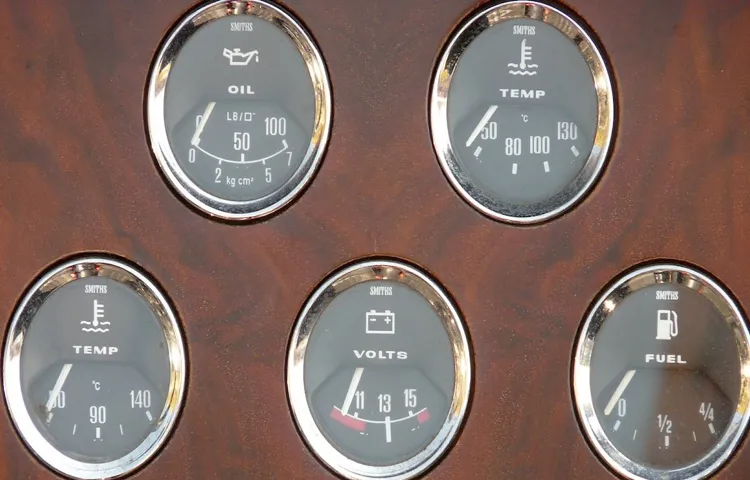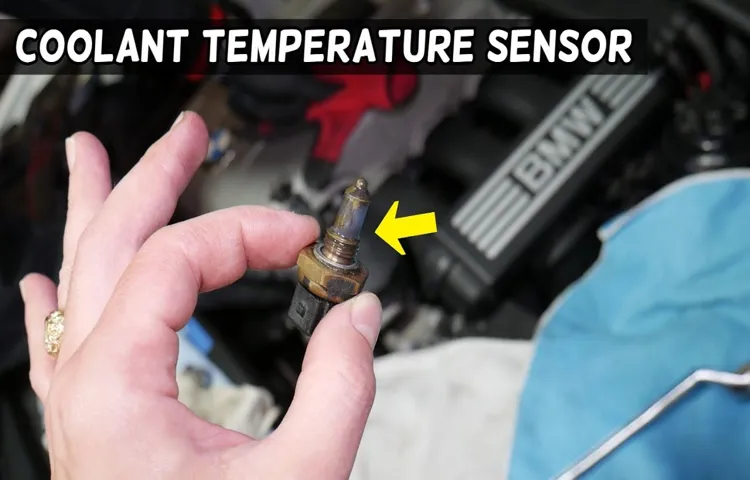Imagine driving down the road on a hot summer day, with the sun beaming down and the temperature rising. Your car’s engine is working hard to keep you moving, but suddenly you notice that something doesn’t seem right. The temperature gauge on your dashboard starts to climb, and you start to worry.
Is your engine overheating? What could be causing this? This is where the coolant temperature sensor comes into play. It may seem like a small, insignificant part of your car’s engine, but it plays a crucial role in keeping your engine running smoothly and preventing it from overheating. So, what exactly is a coolant temperature sensor? Simply put, it is a device that monitors the temperature of your engine coolant.
It measures the temperature and sends this information to your car’s engine control unit (ECU). The ECU then uses this data to adjust various engine parameters, such as fuel delivery and ignition timing, to optimize the engine’s performance. Think of the coolant temperature sensor as the “thermostat” of your car’s engine.
It constantly communicates with the ECU, giving it real-time information about the temperature of the coolant. Just like how a thermostat regulates the temperature in your home, the coolant temperature sensor helps your car’s engine maintain the optimal operating temperature. But why is maintaining the right temperature so important for your engine? Well, too much heat can cause serious damage to your engine components, such as the cylinder head, piston rings, and valves.
On the other hand, if your engine runs too cool, it can lead to poor fuel efficiency and increased exhaust emissions. So, the coolant temperature sensor is like a guardian angel for your engine, continuously monitoring and ensuring that it stays within the safe temperature range. Without it, your engine would be left vulnerable to the perils of overheating or running too cool.
Next time you’re out on the road, take a moment to appreciate the small but mighty coolant temperature sensor under the hood of your car. It may not get the same attention as other parts, but it plays a crucial role in keeping your engine happy and healthy.
Table of Contents
Definition
So, you want to know what a coolant temperature sensor does? Well, think of it as the thermometer for your car’s engine. This little sensor is responsible for measuring the temperature of the coolant flowing through your engine and sending that information to the engine control unit (ECU). Why is this important? Well, the ECU uses this data to make decisions about how much fuel to inject into the engine, when to spark the spark plugs, and even when to turn on the radiator fan.
Without a properly functioning coolant temperature sensor, your engine could overheat and cause significant damage. So, next time you’re driving along and your temperature gauge starts to creep into the red zone, you can thank your coolant temperature sensor for alerting you to a potential problem.
What does a coolant temperature sensor do?
coolant temperature sensor, engine overheating, temperature fluctuations, engine performance, engine control unit, automotive systems. A coolant temperature sensor is an essential component of an engine’s cooling system that helps prevent the engine from overheating. It plays a crucial role in ensuring that the engine operates at optimal temperatures for efficient performance.
The coolant temperature sensor constantly monitors the temperature of the engine coolant and sends this information to the engine control unit (ECU). The ECU uses this data to adjust various parameters such as the fuel injection timing and the cooling fan operation to maintain the right operating temperature. The coolant temperature sensor primarily consists of a thermistor, which is a resistor that changes its resistance with temperature.
As the engine heats up, the resistance of the thermistor decreases, and as the engine cools down, the resistance increases. This change in resistance is used to calculate the coolant temperature. By continuously monitoring the coolant temperature, the sensor helps detect any abnormal temperature fluctuations.
If the coolant temperature becomes too high, it can indicate a potential issue with the cooling system, such as a coolant leak or a faulty thermostat. Conversely, if the coolant temperature is too low, it could indicate a problem with the engine’s heating system. In addition to preventing engine overheating, the coolant temperature sensor also plays a role in optimizing engine performance.
By providing accurate temperature data to the ECU, it allows the engine to operate at the most efficient operating temperature range. This helps improve fuel efficiency and reduce emissions. In conclusion, a coolant temperature sensor is an integral part of the engine cooling system that ensures the engine operates at optimal temperatures while preventing overheating.
By monitoring the coolant temperature and sending this information to the ECU, it helps maintain engine performance and efficiency. So, the next time you drive your car, remember the little sensor that plays a big role in keeping your engine cool!

Function
Have you ever wondered what that little sensor is inside your car engine called the coolant temperature sensor? Well, I’m here to tell you all about it! The coolant temperature sensor plays a crucial role in maintaining the optimal temperature of your engine. It measures the temperature of the engine coolant and sends this information to the engine control unit (ECU). The ECU uses this information to adjust the fuel mixture, ignition timing, and other engine parameters for efficient operation.
In other words, the coolant temperature sensor helps your car’s engine run at its best by ensuring it doesn’t overheat or get too cold. So, the next time you see that little sensor near your engine, you’ll know just how important it is in keeping your car running smoothly.
How does a coolant temperature sensor work?
coolant temperature sensor
Importance
What does a coolant temperature sensor do, and why is it important? Well, think of your car’s engine as the heart of your vehicle. Just like our own hearts, engines need to stay at the right temperature to operate properly. That’s where the coolant temperature sensor comes in.
This little sensor is responsible for monitoring the temperature of the engine coolant and sending that information to the engine control unit (ECU). The ECU then uses that information to adjust things like fuel mixture and ignition timing to ensure that the engine stays within its optimal temperature range. If the coolant temperature gets too high, it could cause the engine to overheat and potentially cause serious damage.
On the other hand, if the coolant temperature gets too low, the engine won’t reach its optimal operating temperature, leading to reduced fuel efficiency and increased emissions. So, you can see why having a properly functioning coolant temperature sensor is so important. It helps to keep your engine running smoothly and efficiently, and it can even help prevent costly repairs down the line.
Why is the coolant temperature sensor important?
coolant temperature sensor, importance, engine performance, overheating, vehicle maintenance The coolant temperature sensor may seem like a small and insignificant part of your vehicle’s engine, but it plays a crucial role in maintaining proper engine performance and preventing overheating. This tiny sensor is responsible for monitoring the temperature of the coolant inside the engine and sending the information to the engine control module. By doing so, it helps the engine control module make adjustments to the fuel mixture and ignition timing, ensuring optimal performance and fuel efficiency.
Additionally, the coolant temperature sensor also alerts the driver if the engine is overheating, allowing for timely intervention before any serious damage occurs. Considering the importance of the coolant temperature sensor, it is essential to prioritize regular vehicle maintenance and inspection to ensure its proper functioning. Routine checks of the coolant temperature sensor and its associated components can help identify any issues or malfunctions early on, preventing expensive repairs in the future.
As a car owner, it is crucial to pay attention to any signs of coolant temperature sensor failure, such as erratic temperature readings, engine performance issues, or warning lights on the dashboard. Ignoring these warning signs can lead to severe engine damage and costly repairs. So, next time you think about skipping that routine maintenance appointment, remember the vital role that the coolant temperature sensor plays in keeping your engine running smoothly and why it should not be overlooked.
Symptoms of a Faulty Coolant Temperature Sensor
The coolant temperature sensor plays a crucial role in monitoring and regulating the temperature of your engine’s coolant. This sensor sends a signal to the engine control unit (ECU) to adjust the air/fuel ratio and ignition timing, ensuring optimal engine performance and fuel efficiency. When the coolant temperature sensor begins to fail, it can cause a variety of symptoms that indicate a problem.
One common symptom is an incorrect reading on the temperature gauge, where the needle may constantly stay in the cold position or fluctuate unexpectedly. Additionally, a faulty sensor can cause the engine to overheat or run too cool, leading to poor performance, reduced fuel efficiency, and potential damage to the engine. It’s important to address any issues with the coolant temperature sensor promptly to avoid further complications.
What are the signs of a bad coolant temperature sensor?
coolant temperature sensor, signs of a bad coolant temperature sensor, symptoms of a faulty coolant temperature sensor, bad sensor, malfunctioning sensor, engine temperature, engine overheating, check engine light, coolant leak
Testing and Replacing the Coolant Temperature Sensor
What does a coolant temperature sensor do? Well, think of it like the thermometer for your car’s engine. This little sensor is responsible for measuring the temperature of the coolant flowing through the engine and sending that information to the engine control module. By constantly monitoring the temperature, the coolant temperature sensor helps to ensure that the engine is running at optimal temperature.
This is important because if the engine gets too hot, it can cause damage to various components and reduce overall performance. On the other hand, if the engine is too cool, it can affect fuel efficiency and emissions. Essentially, the coolant temperature sensor plays a crucial role in helping your engine maintain the perfect balance of heat.
So, if you ever notice issues with your engine overheating or running too cold, it may be time to test or replace your coolant temperature sensor.
How can you test if the coolant temperature sensor is working?
coolant temperature sensor, testing, replacing The coolant temperature sensor is a crucial component of your car’s engine cooling system. It measures the temperature of the coolant and sends this information to the engine control unit (ECU). This data is essential for the ECU to adjust the fuel mixture and ignition timing, ensuring optimal performance and efficiency.
If your coolant temperature sensor is faulty, it may result in poor engine performance, rough idling, or even engine overheating. So, how can you test if your coolant temperature sensor is working properly? One way is to use a multimeter to measure the resistance of the sensor. With the engine cold, disconnect the sensor’s electrical connector and connect the multimeter leads to the pins of the sensor.
Then, gradually heat the sensor using a heat gun or by running the engine and observing the resistance values on the multimeter. If the resistance changes smoothly and within the specified range as the temperature increases, then the sensor is likely functioning correctly. However, if the resistance does not change or fluctuates erratically, then it may be time to replace the coolant temperature sensor.
Remember, it’s always a good idea to consult your vehicle’s manual or seek professional help if you are unsure or uncomfortable with testing or replacing car components.
How to replace a faulty coolant temperature sensor
coolant temperature sensor. If you find yourself in a situation where your car’s engine is running hot or the temperature gauge is showing erratic readings, it could be a sign that your coolant temperature sensor is malfunctioning. The coolant temperature sensor is responsible for monitoring the temperature of the coolant in your engine and sending the information to the engine control unit (ECU).
This information is crucial for the ECU to determine the fuel mixture, ignition timing, and other parameters needed for optimal engine performance. To test whether your coolant temperature sensor is faulty, you can start by visually inspecting it for any physical damage or signs of corrosion. If everything looks okay, you can use a multimeter to measure the resistance across the sensor’s terminals.
The resistance should change as the temperature of the sensor changes. If there is no change in resistance or the readings are off, then it’s likely that the coolant temperature sensor needs to be replaced. Replacing the coolant temperature sensor is a relatively straightforward process.
First, you’ll need to locate the sensor, which is usually found on the engine block or the coolant pipe. Once you’ve found it, you can disconnect the electrical connector by pressing down on the tab and pulling it away. Next, you’ll need to use a wrench or socket to carefully remove the sensor from its housing.
Be mindful not to damage the threads or strip the housing. Before installing the new sensor, make sure to apply some thread sealant to the threads to prevent any coolant leaks. Then, carefully insert the sensor into the housing and tighten it using the wrench or socket.
Once it’s secure, reconnect the electrical connector. After the replacement, it’s important to test the new coolant temperature sensor to ensure it’s functioning correctly. Start the engine and monitor the temperature gauge to see if it’s showing consistent readings.
Conclusion
In the world of automotive engineering, there are mysterious components lurking under the hood, often taken for granted but crucial for the smooth operation of our trusty vehicles. One such unsung hero is the coolant temperature sensor, quietly monitoring the temperature of the engine like a diligent bodyguard protecting its VIP. Imagine this – you’re driving down the road, feeling the wind in your hair and the melody of your favorite tunes making your heart sing.
But unbeknownst to you, under the surface of that serene facade lies a veritable inferno powering your car. That’s where the coolant temperature sensor steps in, making sure that fiery chaos doesn’t spiral out of control. This nifty little sensor is like the Goldilocks of the engine world – it keeps track of the temperature of the coolant, ensuring it’s not too hot, not too cold, but just right.
Just like Goldilocks’ quest for the perfect porridge, the coolant temperature sensor aims to maintain that optimal temperature range for the engine, all day, every day. But why is this temperature so important, you may ask? Well, it’s a crucial piece of the puzzle for the overall health and performance of the engine. If the engine gets too hot, it can cause all sorts of mayhem, like warped cylinder heads, blown gaskets, or even a complete engine meltdown – a scenario that would make even the bravest mechanic break out in a cold sweat.
On the flip side, if the engine stays too cold, it’s like sending a shivering engine into battle, ill-prepared to take on the road ahead. It can lead to increased emissions, poor fuel efficiency, and potentially endless engine problems piling up like regrettable fashion choices from the ’80s. So, dear friends, the coolant temperature sensor is the unsung hero that prevents your engine from turning into a fiery inferno or a freezing wasteland.
It keeps the engine’s temperature just right, ensuring peak performance and preventing catastrophic combustion catastrophes. Next time you turn the key in the ignition, take a moment to appreciate the diligent work of the coolant temperature sensor, silently and efficiently monitoring the engine’s temperature, keeping your ride running smoothly and your adventure on the road neverending. Cheers to the unsung heroes of the automotive world!”
FAQs
What is a coolant temperature sensor?
A coolant temperature sensor is a component in a vehicle’s engine that monitors the temperature of the coolant.
How does a coolant temperature sensor work?
The coolant temperature sensor uses a thermistor to measure the temperature of the coolant. As the temperature changes, the resistance of the thermistor also changes, which is then converted into an electrical signal that is sent to the engine control unit (ECU).
Why is the coolant temperature sensor important?
The coolant temperature sensor is important because it provides vital information to the engine control unit (ECU) about the temperature of the coolant. This information is used by the ECU to adjust fuel mixture, ignition timing, and other engine parameters to ensure optimal performance and fuel efficiency.
What are the symptoms of a faulty coolant temperature sensor?
Some common symptoms of a faulty coolant temperature sensor include inaccurate temperature readings, engine overheating, poor fuel efficiency, rough idle, and a check engine light.
How can I diagnose a faulty coolant temperature sensor?
To diagnose a faulty coolant temperature sensor, you can use a scan tool to read the temperature values reported by the sensor and compare them to the actual temperature of the coolant. Additionally, you can test the resistance of the sensor using a multimeter.
How do I replace a coolant temperature sensor?
The process of replacing a coolant temperature sensor varies depending on the vehicle make and model. Generally, it involves locating the sensor, disconnecting the electrical connector, removing the old sensor, and installing the new sensor. It is recommended to consult the vehicle’s service manual for specific instructions.
Can a faulty coolant temperature sensor cause engine damage?
Yes, a faulty coolant temperature sensor can cause engine damage if it provides inaccurate temperature readings. If the sensor fails to detect an overheating engine, it can result in severe engine damage or even a complete engine failure. It is important to address any issues with the coolant temperature sensor promptly.



